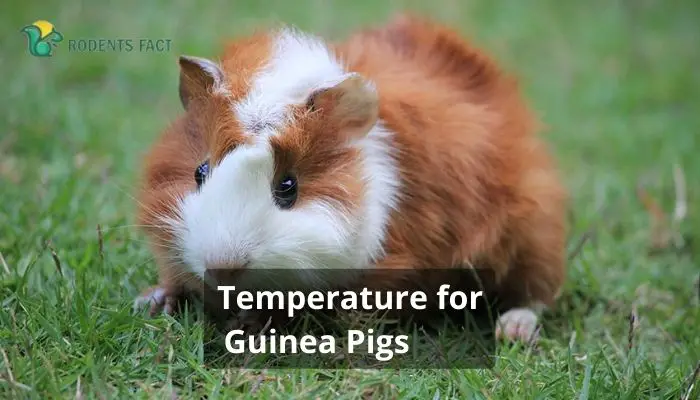What Is The Perfect Temperature for Guinea Pigs?
Having a healthy, happy, and warm-hearted guinea pig is the best sound in the world for guinea pig pet lovers. You should be aware that small animals, such as guinea pigs, have special demands when it comes to keeping warm so that you can provide the finest care possible. So what is the temperature for guinea pigs?

One of a line of guinea pig care and wellness products, this Animal Care Aid is designed to help keep your pet healthy. To prevent putting their health in jeopardy, keep them in temperatures between 60 and 85 degrees Fahrenheit.
A guinea pig can not survive at temperatures that are too high. Learn the indications of heatstroke and how to prevent guinea pig overheating.
What is a Too Hot Temperature for Guinea Pigs?
Temperatures over 75 degrees Fahrenheit are hazardous for guinea pigs. Temperatures should be kept between 60 and 75 degrees for this cat.

A guinea pig may suffer heatstroke if exposed to temperatures above 75 degrees Fahrenheit. A guinea pig may die from overheating.
Why Is Guinea Pig Cage Temperature Important?
This fuzzy creature does not sweat. Hence it can not emit heat.
Controlling and monitoring its cage temperature is crucial. Guinea pigs overheat in minutes. This may cause cardiac failure in guinea pigs.

How Do Wild Guinea Pigs Control Temperature?
Wild guinea pigs have many techniques to avoid overheating. When it gets hot, they may go inside their burrow.

Guinea pigs inhabit animal burrows. Since a burrow is located beneath, it is naturally colder. Burrows offers shade for wild guinea pigs.
Hamsters also drink water to avoid heat stroke. Their body stays cool.
What Are Some Signs That a Guinea Pig is Overheated?
If a room’s temperature is above 75 degrees Fahrenheit, check for symptoms your pet is overheating. First, calm down the guinea pig.

Guinea pigs pant with their mouths open and laborious breathing. The animal opens its mouth to discharge body heat.
Overheated guinea pigs are also lethargic. The pet may lie sideways on the cage floor. The guinea pig is overheating. This creature seldom even sleeps in its cage.
Easy Ways to Keep a Guinea Pig’s Cage Comfortable
The best technique to avoid overheating and heat exhaustion are to have a thermometer near the guinea pig’s cage. So, a homeowner may detect whether the room temperature is increasing and intervene.
Always provide your pet with cold water. Guinea pigs often spill their water dishes, so use a water bottle instead. Choose a large water dish for a guinea pig if you want one.

A guinea pig’s cage should be air-conditioned throughout the heat. Owners may also use portable fans. A fan circulates indoor air.
Check the room temperatures before obtaining a guinea pig. This helps you decide where to put your pet’s cage. Take room temperatures in different spots. Large room temperatures may fluctuate.
How Can You Cool an Overheated Guinea Pig?
Overheated guinea pigs require immediate veterinary care. A guinea pig owner can do a few things until the vet arrives.

Cool the guinea pig’s water. A guinea pig on its cage floor may swallow eyedroppers of water.
Cool the guinea pig’s feet. This lowers the pet’s body temperature. Spray a guinea pig with cool water to reduce its body temperature.
Overheated guinea pigs benefit from a wet towel. Wet towel, not dripping. Wrap the towel over the pet’s torso, not it’s head.
Winter Care for Guinea Pigs
Winter’s main issue is cold. Young and ill cavies need additional warmth. Due to cold and humidity, keep guinea pigs inside.
Beware temperature dips. Rapid temperature swings are unhealthy. Using thermometers and thermostats, maintain room temperature. Do not assume your pet will be “fine” if you switch off the heat and browse the web at work.
- Wet and chilly bedding is neither safe nor pleasant.
- Use white paper, wood shavings, and hay to thicken their bedding.
- Winter is a good time to realize you need more than one guinea pig; they can keep each other warm.
- Keep cavies out of the draft!
- Lift the cage (hutch). It is chilly. Use wood, brick, or furniture.
- Towels, blankets, and old socks are suitable for cuddling.

Summer Care for Guinea Pigs
Your cavie has limited heat tolerance. Always:
- Keep them in the cool shade
- DO NOT leave them in direct sunlight or drafts with nowhere to hide.
- Make sure there is enough fresh water to drink.
- Cucumbers, peppers, and strawberries are watery summer pleasures.
- Keep the cage clean. Pets consume more water and urinate more often.
A fantastic technique several owners use is: Put an ice block in a cage corner wrapped with a towel or cloth. Guinea pigs can cool off in the water. Use a heavier fabric if it is cold.

Frequently Asked Questions
1. What Temperature Is Too Cold for Guinea Pigs?
The RSPCA advises that temperatures below 15 degrees are too cold for Guinea Pigs and that they should be kept indoors.

2. What Temperature Is Too Hot for Guinea Pigs?
Many people wonder how to keep guinea pigs cool in the summer. Guinea pigs should be kept in temperatures around 65 – 75 degrees Fahrenheit. Above 80 degrees or below 60 degrees is detrimental to their health.
3. What Is a Good Temperature for Guinea Pigs?
Guinea pigs are susceptible to both heat and cold. Keep them in temperatures between 60 and 85 °F to avoid putting their health at risk.
4. Can Guinea Pigs Stay In AC?
Fans can help cool the air, but the feeling of having air constantly blown at it can stress out your guinea pig. Your guinea pig’s cage should never be colder than 50 °F (10 °C).
Let’s see piggies’ room temperature suggestion from an expert:
5. Do Guinea Pigs Like the Cold?
Some rodents, like ground squirrels or Eastern chipmunks, and hamsters hibernate when the weather turns cold, but guinea pigs don’t. Instead, guinea pigs are most comfortable in air temperatures of about 65°F to 75°F.
Final Words
Keeping guinea pigs cool in the summer and warm in winter is essential if you’re thinking of keeping them outside. Now you know the temperature for guinea pigs.
If your guinea pig is used to living indoors, you may wish to gradually build up the time spent outside so as not to shock them with a temperature change. Again, if you’re ever unsure, we recommend consulting with a vet for further advice.




